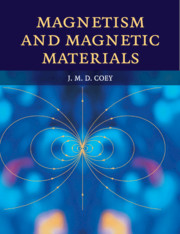Book contents
- Frontmatter
- Contents
- List of tables of numerical data
- Preface
- Acknowledgements
- 1 Introduction
- 2 Magnetostatics
- 3 Magnetism of electrons
- 4 Magnetism of localized electrons on the atom
- 5 Ferromagnetism and exchange
- 6 Antiferromagnetism and other magnetic order
- 7 Micromagnetism, domains and hysteresis
- 8 Nanoscale magnetism
- 9 Magnetic resonance
- 10 Experimental methods
- 11 Magnetic materials
- 12 Applications of soft magnets
- 13 Applications of hard magnets
- 14 Spin electronics and magnetic recording
- 15 Special topics
- Appendices
- Formula index
- Index
- Tables, conversions, constants and units
6 - Antiferromagnetism and other magnetic order
Published online by Cambridge University Press: 05 June 2012
- Frontmatter
- Contents
- List of tables of numerical data
- Preface
- Acknowledgements
- 1 Introduction
- 2 Magnetostatics
- 3 Magnetism of electrons
- 4 Magnetism of localized electrons on the atom
- 5 Ferromagnetism and exchange
- 6 Antiferromagnetism and other magnetic order
- 7 Micromagnetism, domains and hysteresis
- 8 Nanoscale magnetism
- 9 Magnetic resonance
- 10 Experimental methods
- 11 Magnetic materials
- 12 Applications of soft magnets
- 13 Applications of hard magnets
- 14 Spin electronics and magnetic recording
- 15 Special topics
- Appendices
- Formula index
- Index
- Tables, conversions, constants and units
Summary
Je prefere explorer les forêts vierges que cultiver un jardin de curé.
Louis NéelNegative exchange J < 0 leads to magnetic order that depends on lattice topology. Structures with more than one magnetic sublattice include antiferromagnets and ferrimagnets. An antiferromagnet has two equal but oppositely directed sublattices, where the sublattice magnetization disappears above the Néel point TN. Two unequal oppositely directed magnetic lattices constitute a ferrimagnet. The molecular field theory is extended to cover these cases. A wealth of more complex noncollinear magnetic structures exist. The subtle effects of a noncrystalline structure are manifest in amorphous magnets, where spins sometimes freeze in random orientations. Magnetic model systems highlight the influence of some particular feature on collective magnetic order, such as reduced space or spin dimensionality, a particular distribution of exchange interactions, special topology or lack of crystal structure. Examples include the two-dimensional Ising model, frustrated antiferromagnets and canonical spin glasses.
Antiferromagnetism is an occult magnetic order. A crystal lattice is subdivided into two or more atomic sublattices which order in such a way that their net magnetization is zero. Louis Néel, who was a student of Pierre Weiss, first discussed this possibility in 1936 for two equal and oppositely aligned sublattices. The antiferromagnetic ordering transition, known as the Néel point, is marked by a small peak in the magnetic susceptibility, and a substantial specific heat anomaly, similar to that found at the Curie point of a ferromagnet (Fig. 5.36).
- Type
- Chapter
- Information
- Magnetism and Magnetic Materials , pp. 195 - 230Publisher: Cambridge University PressPrint publication year: 2010

